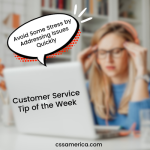
In talking with a client recently, they shared their approach to developing future services. Thinking 10 years down the road, they noted how technology, the community, and customer needs all would change.
This is a company with strong relationships with customers, and although they value innovation and creativity, what they value most is the relationship with their customers.
The core of their development of new services was described, and if you pulled out all the fancy terminology and new age infographics, their approach to new service development is simply based on having ongoing dialogue with customers.
The company described an iterative process where they initiate dialogue with current customers and non-customers. They ask about changing needs, preferences, and desires. They ask anticipatory questions about future trends, and they ask about what the company could best do with services and the experience used to deliver the services.
In short, they let customer dialogue drive the approach to service delivery.
Your customers use your services, they pay for your products, they judge your experience, and they stay or leave – they talk you up or down with friends – based on their opinion of your organization.
Uncover what they want and need and how they’d like to receive it, then deliver on those desires.
Let Dialogue Drive Service Delivery.
Signup for FREE Tips! Contact Us More Resources for You Visit Our Home Page






















